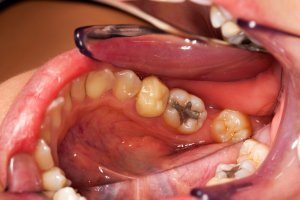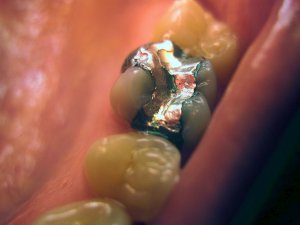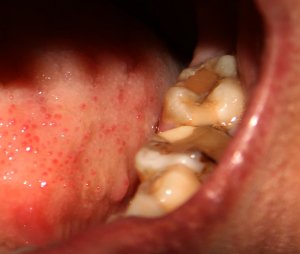Silver amalgam fillings are widely offered on the NHS when a white composite filling is not deemed necessary. Private practices also offer silver fillings to patients who want the cheapest, non-cosmetic option.
But because silver fillings contain mercury, many people ask the question: Are amalgam fillings safe?
If you’re worried about mercury poisoning from fillings and you want to know the benefits of white fillings vs. silver, you’re in the right place. Here you can discover the facts about what teeth fillings are made of, results from scientific studies, and the practical pros and cons of different filling materials.
Do you want to get your amalgam fillings removed, whether for cosmetic or health reasons? Read the arguments for and against replacing silver fillings with white composite ones before you decide what to do.
We hope this information empowers you to make the right choice for restoring your teeth!
In This Article
What are fillings made of?
The purpose of a tooth filling is to repair, strengthen and protect teeth that have been damaged by tooth decay.
In this article, we’re going to focus on the two most common materials used for dental fillings in the UK: amalgam (silver metal) and composite (tooth-coloured material). Other materials like glass ionomer and gold are also available but are less often used.
Silver amalgam fillings

It’s almost 200 years since dental amalgam was first used in Europe to fill teeth cavities. Its quality has improved greatly over the years, as have the dentistry techniques used to place fillings. It’s now the most commonly used type of filling around the world, according to the World Health Organization.
Amalgam fillings may be called ‘silver fillings‘ or ‘black fillings‘ because of their colour (they become darker over time). They’re also known as ‘mercury fillings‘ because – you guessed it – there is mercury in amalgam fillings. It’s this ingredient that has made dental amalgam the subject of continuing controversy, due to concerns about its impact on human health both directly and through environmental pollution. Later in this article, we’ll look at whether these concerns are warranted and what side effects silver fillings might lead to.
Dental amalgam definition
For now, let’s look at the basics: what is amalgam filling?
Dental amalgam is a metal made by mixing elemental (liquid) mercury with silver, tin and copper in powdered form.

The percentage of mercury in amalgam fillings is around 50%, then about 20% silver, 16% tin, 15% copper plus other trace metals. The exact composition your dentist uses may vary slightly, but there is always between 45% and 55% mercury in amalgam fillings.
Once the mercury is mixed with the other metals it forms a putty that can be easily pressed into the cavity being filled. It takes around 24 hours to fully harden.
Pros and cons of amalgam

Aside from concerns over toxicity, which we’ll explore later, the main drawback of amalgam is the ‘metal teeth‘ look. A silver tooth filling might not bother you if it’s tucked away at the back of your mouth, but many people don’t like the idea of others being able to see their fillings when they smile or laugh.
On the plus side, amalgam fillings are cheaper than any other kind and are available to NHS patients. They are also relatively straightforward to place, meaning you spend less time in the dentist’s chair.
From a technical point of view, amalgam is quick and easy to place compared to other types of filling. However, because it doesn’t chemically bond with the tooth, some of the healthy tooth structure has to be removed in order to prepare a space that will keep the filling secure. It is therefore a more invasive type of filling which weakens the tooth structure and increases the risk of tooth fractures.
White composite fillings
The most common type of amalgam-free filling material is resin composite. There are various different formulae used for dental composite, but they all contain a kind of synthetic resin that gives them a plastic-like composition.
Composite fillings were first introduced in the 1960s and have undergone various changes and refinements in the decades since. Improvements are still ongoing, and it’s realistic to expect that composite – or some other alternative – will eventually replace amalgam completely. In many Scandinavian countries, amalgam is more or less abolished and used in only very few cases.
While in the past, white fillings used to be weaker than metal fillings, the new generations of composite material are very compatible with the strength of natural teeth.
This means that composite, or white, fillings, are in no way more fragile than metal fillings.
Dr Azad Eyrumlu
You’ll notice there’s no section devoted to the topic “Are composite resin fillings safe?” – simply because there are no real concerns about the safety or toxicity of composite fillings.
It is worth noting that the majority of composites contain derivatives of BPA – a chemical found in many plastics which can disrupt hormones in the body. No studies have shown that composites containing BPA are harmful to humans. However, BPA-free composites are available to patients who want to avoid this chemical. Ask your dentist about the options if this is something you’re worried about.
Pros and cons of composite

Composite fillings are shaded to match the natural tooth colour as closely as possible, making them almost undetectable. Over time, however, resin composite can stain and become more noticeable. It can also shrink slightly if not set properly, creating small gaps that harbour bacteria.
The process for placing composite fillings requires more time and skill than amalgam. The tooth surface must be kept completely dry while the surface is etched and the filling is built up in layers that are cured one at a time. One benefit of composite is that it chemically bonds to the tooth structure which offers extra support and means that no additional healthy tooth has to be removed in the process.
For a long time, amalgam was regarded as the best direct filling material in terms of strength and durability. Metal fillings last 10-15 years and can withstand a great deal of pressure on biting surfaces of the teeth. However, as composite resins improve, they are edging closer to rivalling amalgam in this regard.
Still, dentists may advise against using composite for large fillings and those in stress-bearing positions because of its physical limitations. White fillings usually need to be replaced after 5-10 years – and sooner if they crack or fracture under pressure.
Amalgam fillings vs. composite
In the table below you can see a summary of the main differences between silver fillings and white fillings.
[
Amalgam fillings | Composite fillings | |
Appearance | Silver coloured, may become black | Tooth coloured, may stain over time |
Cost | £30 - £160, available on NHS | £40 - £250, available on NHS in some circumstances |
Made from | Mercury, silver, tin, copper & other metals | Synthetic resin and other ingredients |
Safety | Can cause allergies, toxicity concerns, require proper disposal | Often contains BPA but BPA-free options are available |
Strength | Can cause allergies, toxicity concerns, require proper disposal | Often contains BPA but BPA-free options are available |
Durability | Last 10-15 years | Last 5-10 years |
Ease of placement | Relatively straightforward procedure | More complex and lengthy procedure |
Impact on tooth structure | Some healthy tooth must be removed | Bond directly to tooth structure, minimising removal of healthy tooth |
Time to set | 24 hours | None - hardens during filling process |
Other uses | Dental crowns | Repairing chipped or broken teeth |
In cases where composite is not a suitable replacement for amalgam, a porcelain inlay or tooth crown would be the next option to consider.
Are amalgam fillings safe?
For almost as long as they have been in use in the Western world, people have questioned whether mercury amalgam fillings are safe. Perhaps with good cause – at least initially – since amalgam was mixed and applied somewhat primitively when it was first used.
Now, with much improved formulae and dentistry techniques, dental amalgam is recognised as safe by numerous health organisations worldwide. Extensive scientific research has been conducted to examine the potential health problems stemming from dental amalgam, but no

The World Dental Federation (FDI) represents over 1 million dentists in nearly 130 countries. “The current weight of evidence is that contemporary dental restorative materials, including dental amalgam, are considered to be safe and effective,” reads a statement on their website, released in conjunction with the World Health Organization.
The NHS, Oral Health Foundation and British Dental Association all take a similar stance. The USA’s Food and Drug Administration (FDA) “considers dental amalgam fillings safe for adults and children ages 6 and above” based on the best available scientific evidence.
The only countries that have banned the use of dental amalgam outright are Norway and Sweden. In both cases, a wide range of mercury-based products were phased out for environmental reasons.
A study published by the Norwegian Institute of Public Health in 2016 examined various side effects experienced by patients with amalgam vs. composite fillings. The research found that although patients with amalgam fillings had slightly higher levels of mercury in their urine after both five and seven years than those with composite, there were no significant differences in kidney function, neurological function, and a range of other measures.
“Amalgam poisoning” claims
So why do some people still claim that silver tooth fillings have a detrimental effect on people’s health? You don’t have to look far online to find long lists of supposed amalgam tooth filling side effects, including serious neurological disorders such as Alzheimer’s, Multiple Sclerosis and Parkinson’s.
The case against metal fillings usually centres around one or more of the following:
- Allergic reactions to mercury fillings
- Mercury poisoning from tooth fillings (leading to many different side effects)
- Environmental contamination from mercury in amalgam
So let’s explore each of these issues in more detail.
Can you be allergic to amalgam fillings?

In short, yes. It’s estimated that between 1% and 3% of the population experience sensitivity to one of the metals present in dental amalgam, resulting in an allergic reaction.
Symptoms of an amalgam filling allergy usually present as a rash, inflammation, burning or oral lesions near the filling site, which appears as white patches. Patients may also experience itching or hives on other parts of their bodies. After the filling is removed and replaced with another material, these side effects should disappear.
If you experience any of these symptoms or find yourself in severe pain after an amalgam filling, contact your dentist straight away.
Can you get mercury poisoning from fillings?
First, let’s acknowledge that mercury is known to be toxic to humans in sufficient quantities. Mercury occurs naturally in water, air and soil, and most of us have a small but measurable amount present in our bodies. Eating fish and seafood contributes to this, but it does also come from dental amalgam used in fillings (and other sources). Exposure to large amounts of mercury can cause poisoning, particularly affecting the brain and kidneys.
So are mercury fillings dangerous? Is there such a thing as dental amalgam poisoning?
The highest risk of exposure to mercury comes while placing and removing amalgam restorations. Once the filling is in place, only trace amounts of mercury are released from fillings while biting and chewing. People who habitually grind their teeth may be at increased risk since they may gradually grind their fillings down.

Some people claim that having their fillings removed has cured them of mercury poisoning symptoms such as:
- Tiredness
- Headaches
- Sort-term memory problems
- Depression
- Mood swings
- Poor attention span
- Physical tremors
However, there is no clinical research to back these claims up. Studies such as this one continue to agree that, despite dental amalgam coming under such tight scrutiny, it has no evident adverse health effects on the general population.
There is also no scientific evidence to suggest that amalgam fillings are responsible for conditions such as autism, Alzheimer’s and MS; nor is there any solid proof that removing fillings relieves these and other symptoms (except in the case of allergies).
For a more detailed examination of possible mercury amalgam poisoning from tooth fillings, this article is a good read.
The environmental impact of mercury amalgam
By far the biggest known disadvantage of amalgam fillings is the release of mercury into the environment. As things currently stand, the main risk of mercury amalgam poisoning comes not from the fillings in your own teeth, but from other people’s old fillings that aren’t disposed of correctly.
This study states that dental amalgam is often the largest source of mercury in municipal wastewater, and it also contributes towards mercury pollution in the soil and air. Most of this comes directly from dental clinics, but mercury can also end up in the environment through the burial or cremation of deceased people who had silver tooth fillings.
Why is this a problem?

The elemental form of mercury used in teeth fillings is relatively stable. But if this mercury makes its way into the environment it can be converted into toxic methylmercury. This easily enters the food chain, particularly through fish and seafood, and it’s in this way that humans become exposed to mercury in its most harmful form.
Banning dental amalgam is one way to stop this problem, but until that happens, the next best solution is to ensure it’s disposed of properly.
Some countries have implemented strict regulations for the disposal of dental amalgam. For instance, as of 1 January 2018, EU dentists must have amalgam waste collected by an authorised waste management company. Elsewhere, particularly in developing countries, amalgam can end up in general waste with no special treatment.
The Minamata Treaty of 2013 brought together 140 countries in a commitment to reduce the amount of mercury released into the environment from sources including dental amalgam, batteries and cosmetics. This led to the introduction of new EU legislation in 2018 which, among other things, prohibits the use of dental amalgam in children under 15 and pregnant and breastfeeding women, unless there is a specific medical need for it.
Some campaigners have used this to fuel the argument that dental amalgam is unsafe to use, but it must be stressed that the legislation stems from environmental (rather than health) concerns.
Why do dentists still use silver fillings?
With all this controversy over the use of mercury fillings, you might be wondering why we don’t just stop using them. Although some dentists in the UK now operate ‘mercury-free’ dental practices, the majority still use dental amalgam – including all NHS dentists.
The reason for this is simple: no other filling material is as cheap, durable and easy to place as amalgam. And the NHS pays dentists for only basic dental work. Banning amalgam outright would make basic dental care unaffordable for more people.
There is certainly pressure for dentists worldwide to phase down their use of amalgam, mainly for environmental reasons, so it’s likely we will see more and more countries introducing restrictions on amalgam fillings and promoting the use of alternative materials.
Getting dental fillings during pregnancy and breastfeeding
Pregnancy hormones make women more susceptible to oral health problems such as gingivitis, so it’s important to continue regular dental checkups while pregnant. NHS dental care is free for pregnant women and those who have given birth in the last year.

It’s perfectly safe to get your teeth cleaned at the dentist during pregnancy to maintain good oral health. However, dentists may prefer to postpone more intrusive procedures – especially those requiring anaesthetic – until after the birth, unless there is an urgent need (e.g. if you are in pain).
If your dentist identifies a dental cavity while you’re pregnant, he or she will assess how urgently you need a filling and will advise you accordingly.
Note that if you do need a filling while pregnant or breastfeeding, the EU regulations introduced in 2018 mean that dentists shouldn’t use dental amalgam unless there is a clinical reason to do so. Instead, they should offer you composite or another alternative. These regulations are in place to reduce the environmental impact of mercury; not because of any proven health risks.
Amalgam fillings removal
Having read all of this, you can now make a more informed decision about whether to get amalgam fillings or composite next time the need arises. But what about removing any existing amalgam fillings and replacing them with composite?
You might be considering mercury filling removal because of cosmetic reasons, health concerns, or a combination of the two. Or perhaps an old silver filling hurts and there is a medical need to replace it.
Getting silver fillings replaced with white

The general consensus is that the benefits of removing amalgam fillings don’t outweigh the benefits of keeping them in place, provided they are still mechanically sound.
The Oral Health Foundation “advises patients not to have their amalgam fillings replaced unless they are certain they are allergic to dental amalgam, as the process of removal can weaken the teeth.”
The British Dental Association takes a similar stance: “There is no justification for removing clinically satisfactory dental amalgam restorations as a precaution, except in those patients properly diagnosed as having allergic reactions to amalgam constituents.”
The pros and cons of amalgam filling removal are summed up in the table below:
Benefits of removing amalgam fillings | Side effects of removing amalgam fillings |
Better cosmetics (if replaced with tooth-coloured composite) | Temporarily releases mercury vapour which you may inhale |
No continued exposure to low levels of mercury from chewing | Weakens tooth structure |
Deals with any allergic reaction to amalgam ingredients | Increases the chances of needing root canal work later on |
Drilling closer to the nerve may cause sensitivity |
Because of all the possible risks, dentists will often advise against replacing silver fillings with composite unless:
- You have experienced an allergic reaction to dental amalgam
- An old amalgam filling has cracked, shrunk, come loose, or failed in some other way
- A tooth with a metal filling has developed secondary dental caries (tooth decay under the filling)
That’s not to say you’ll have trouble finding a dentist willing to remove your amalgam fillings for other reasons if that’s the treatment you choose. Increasing numbers of dentists now specialise in safe amalgam filling removal because of the growing demand for this procedure.
If you wait until your old black fillings have come to the end of their life and need to be replaced anyway, there is no reason not to replace your silver fillings with white fillings – as long as you’re prepared to pay for private treatment (more on costs below).
How to safely remove mercury fillings

Mercury amalgam fillings usually last 10-15 years. Once they start to show signs of failing, silver fillings need to be replaced. Because some mercury vapour is released during amalgam filling removal, dentists should take special precautions to protect themselves and the patient from the risk of mercury exposure.
For the most secure mercury tooth filling removal, find a dentist who uses SMART (Safe Mercury Amalgam Removal Technique), a protocol recommended by the International Academy of Oral Medicine & Toxicology (IAOMT).
Safety measures utilised in this technique include:
- Using a filtration system in the room
- Giving the patient an adsorbent solution (often containing charcoal) to rinse and swallow before the procedure
- Fitting a nasal mask to the patient so they have a clean air supply
- Using a dental dam to seal off the tooth being treated
- Using a high-speed saliva evacuator (suction tool)
- Keeping the filling cool during removal
- Removing the amalgam in as large chunks as possible
- Disposing of the old filling material in a safe way
- Using specialist filters in the suction system so waste and mercury do not mix
Dental staff will also use special equipment to protect themselves from exposure to mercury vapour. In the video below you can see how this looks in practice:
In reality, not many dentists in the UK use this exact protocol – and those that do charge accordingly. Before getting amalgam fillings removed, ask your dentist what technique they use and what special safety measures they have in place during the process. If you feel that they take inadequate precautions, you can always look elsewhere for a clinic that specialises in this procedure.
You might also consider visiting a dentist overseas to save money on filling removal – particularly if you have several teeth that need work. That said, some dentists recommend treating one tooth at a time, with several months between treatments, to minimise the side effects of any mercury that is released during the process.
What does replacing silver fillings with white cost?
The cost to remove amalgam fillings depends on an important distinction:
If it’s your choice to have your silver fillings removed, none of the treatment will be covered on the NHS (even if you have your dentist’s full support). The cost of safe amalgam filling removal with a dentist who specialises in this procedure (using the SMART process described above) can be as much as £200-£300 per tooth – plus the cost of the filling. Dentists who don’t have quite such extensive safety precautions in place might charge considerably less.
If there is a clinical need to remove your old fillings, this part of the process may be covered on the NHS. If you originally got your amalgam fillings on the NHS, chances are you’ll only be offered amalgam as a replacement on the NHS. The exception would be if you have had an allergic reaction or if you now fall into one of the exempt groups mentioned earlier.
If you choose to replace your amalgam fillings with composite instead, you’ll have to pay for the white fillings privately. The cost of a single white filling in the UK can be anywhere from £40 to £250 or more, depending on the size of the cavity and other factors.

Some dental insurance policies may cover part of the cost associated with this procedure. You’ll need to check your policy for details though. Base-level policies generally have no allowance for elective cosmetic treatment.
Conclusion
There are many factors to consider when deciding whether to get silver or white fillings.
Dentists worldwide are gradually moving away from using dental amalgam, but this is largely because of environmental concerns about mercury toxicity. Regardless of any health concerns, many people wish to avoid metal fillings because of their aesthetics. Composite fillings are far less noticeable but aren’t as strong and durable as amalgam, especially in stress-bearing positions. Composite also costs more than amalgam.
Replacing silver fillings with white for purely cosmetic reasons is generally not advised, due to the risk of exposure to mercury vapour and possible complications. However, many dentists do offer this procedure and take steps to ensure it’s done as safely as possible.
If you need a new filling and would prefer not to have amalgam, speak to your dentist about the other possibilities. If a composite filling won’t do the job well enough, a porcelain inlay may work instead.
Mercury fillings FAQs
Can mercury leak from amalgam fillings?
Silver mercury amalgam does emit tiny amounts of mercury vapour, mainly during the placement and removal of the filling. But, don’t worry, it doesn’t drip into your mouth like a leaking tap. The mercury in amalgam fillings is chemically bonded to other metals to make it more stable.
Is it safe to remove amalgam fillings during pregnancy?

There is no scientific evidence to show that your existing amalgam fillings have harmful effects on the health of you or your infant. But when removed, a small amount of mercury vapour is released. If this enters the mother’s body it can be passed onto her infant through the placenta or while breastfeeding.
Therefore, dentists won’t remove amalgam fillings during pregnancy unless absolutely necessary, i.e. if a filling is broken or there is further decay requiring urgent treatment.
Can you cover silver fillings with white?
It is actually possible to mix the two materials in what is knows as the ‘sandwich technique’. However, this is only the preferred case where removing the silver filling undermines the tooth structure and makes a new filling impossible.
It’s not possible to simply cover a silver filling with white without removing some of the amalgam since this would affect the bite.
Can you replace silver fillings with white fillings?
Yes, absolutely. It is a relatively common procedure to replace amalgam fillings with composite fillings whether it’s because of health concerns or cosmetic preferences. The part people don’t agree on is whether it’s a good idea to remove amalgam fillings before they have come to the end of their natural life. Removing them releases mercury vapour, so many dentists will advise against this unless it’s clinically necessary.
Can any dentist remove silver fillings safely?
Yes, dentists are trained to provide the safe removal of all fillings and their governing body ensures standards are met in doing so safely both for their patients and the environment.
Can I refuse to have silver fillings?
Yes, you must always be given the option for an alternative filling material whether you see a dentist on the NHS or privately.





